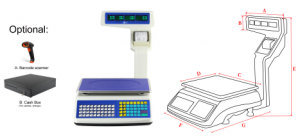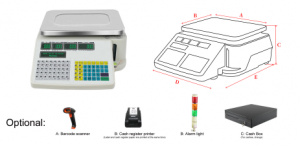Ⅰ:
Unlike mechanical scales, electronic scales use the principle of electromagnetic force balance for experimental weighing, and have built-in load cells, whose performance directly affects the accuracy and stability of electronic scales. However, various external environments and electromagnetic interference will affect its accuracy and stability, so we should pay attention to the correct use method when using electronic scales, because this will improve its weighing accuracy and prolong its service life. So what should we do if the electronic scale is abnormal during use? The following are some common electronic scale fault inspection methods. Interested friends may wish to learn about them.
Ⅱ:
Different from mechanical scales, electronic scales use the electromagnetic force balance principle for experimental weighing, and have built-in load cells, whose performance directly affects the accuracy and stability of electronic scales. However, various external environments and electromagnetic interference will affect its accuracy and stability, so we should pay attention to the correct use method when using electronic scales, because this will improve its weighing accuracy and prolong its service life. So what should we do if the electronic scale is abnormal during use? The following are some common electronic scale fault inspection methods. Interested friends may wish to learn about them.
Ⅲ:
The inspection methods of electronic scales’ common fault:
1. Intuitive Method
There are many components on the main circuit board of the electronic scale, and many faults occur due to short circuit, open circuit, poor contact of plug and socket, and open welding of component tube corners. Therefore, when the pricing scale fails, you should first check the circuit board with intuitive sense: sight, hearing, smell, touch and other methods.
2. Comparison and Substitution Method
During fault inspection, the electronic scale can be compared with the faulty scale with the help of the instrument, and the fault point can be found out quickly. In addition, if the sensor, circuit board, power supply, keyboard and other components prepared at work are suspected to be damaged, replace it with the prepared component, and then observe whether the result changes. If it is normal, it means that there is a problem with the original component. The comparison and substitution method can quickly and accurately determine the fault point.
3. Voltage Measurement Method
The electronic scale compares the measurement of the working voltage of the circuit components and each tube angle of the chip with the normal value. The place where the voltage changes greatly is the place of the fault.
4. Short Circuit and Open Circuit Method
The short-circuit method is to short-circuit a certain part of the circuit, and the electronic scale then judges the fault point through the results of the oscilloscope or multimeter test. The open circuit method is to disconnect a certain part of the circuit, and then use a multimeter to measure the resistance, voltage or current to determine the fault point.
Post time: Jun-15-2022







